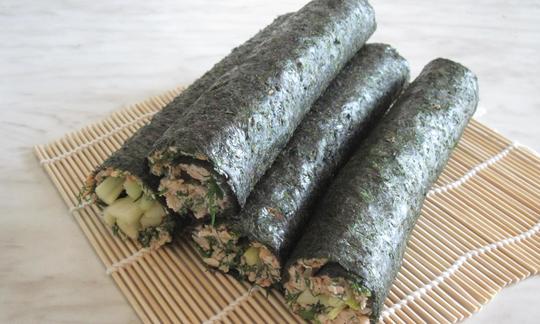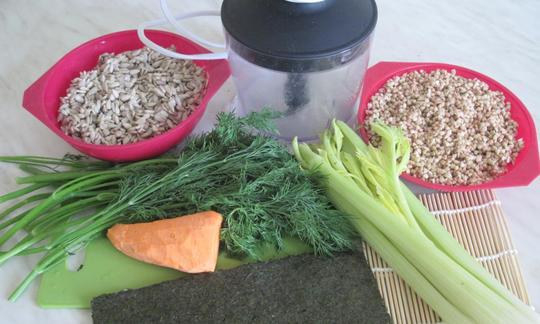Raw Sushi with Celery and Sunflower Seeds
raw-vegan
Ingredients (for servings, )
| For the rice substitute | |
|---|---|
| 3 ½ oz | Buckwheat, raw (organic?) |
| 7 ⅓ oz | Sunflower seeds, raw (organic?) |
| 3 tbsp, ground | Linseed, raw, organic? (golden linseed, flax) (0.74 oz) |
| 1 | Carrots (carrots), raw (organic?) (2.1 oz) |
| 1 ¾ oz | Dill, raw (herb, seeds, organic?) |
| For the filling | |
| 6 | Celery (bleached celery), raw (organic?) (105 oz) |
| Rolling the sushi | |
| 4 | Nori sheets (raw? organic?) (0.37 oz) |
Equipment
- blender or hand-held blender / immersion blender
- sprouter (sprouting jar)
- mandoline
- coffee grinder, electric
Type of preparation
- sprouted
- chop or grind
- soak
- peel
- grate (shred)
Preparation
For the rice substitute
Sprout the buckwheat in a sprouter for 24 hours. If you don’t have a sprouter, you can use any type of flat container.For sprouting, you need to use raw buckwheat (not roasted). Don’t let the seedlings grow too long; it’s better to use seedlings that have just sprouted. If you don’t want to sprout the buckwheat, it has to be soaked for at least 12 hours. In this case, cover the buckwheat with water. Sprouting, in contrast, only works in a damp environment because too much water causes the seeds to die instead of sprout.
Wash the sunflower seeds and soak in water for at least 4 hours.
Wash the sprouted buckwheat well and coarsely grind in a blender. The consistency should be similar to that of rice; it gives the sushi its distinctive taste.
Grind the flaxseeds in an electric coffee grinder. Then transfer to the bowl with the rice mixture and mix well.
Wash and peel the medium-size carrot(s). Slice the carrots thinly using a mandoline or vegetable slicer. Then add to the bowl.
A V-blade mandoline is a special type of vegetable slicer with a V-shaped blade that allows the food to be sliced evenly on both sides. This type of mandoline is easier to use and makes a cleaner cut. Food items are slid back and forth over the blade, which allows very thin slices to be made. Most mandolines have a food holder that securely holds the food in place on plastic spikes and protects fingers from injury.
Wash and finely chop the dill. Add to the bowl and mix in well. If the mixture is somewhat dry and not sticky, add a little water.
For the filling
Wash the celery and cut into pieces about 6 cm in length.Rolling the sushi
Spread the “rice” on the rough side of the nori sheet until about two-thirds of the surface is covered. Then place the celery pieces in a row a little closer to the edge and roll the sushi up. To make sure the roll holds tight, wet the nori sheet just before using and then press firmly together after rolling.It is important to wet the nori sheet directly before rolling. If you do so earlier, the nori sheet will be too moist and fall apart. You can also use a little lemon or lime juice to do this.
If you like, serve the sushi with soy sauce or raw mayonnaise. Enjoy!
|
Nutritional Information per person
Convert per 100g
|
2000 kcal | |
|---|---|---|
| Energy | 273 kcal | 13.7% |
| Fat/Lipids | 15 g | 21.7% |
| Saturated Fats | 1.5 g | 7.4% |
| Carbohydrates (inc.dietary fiber) | 27 g | 10.2% |
| Sugars | 6.1 g | 6.8% |
| Fiber | 11 g | 42.3% |
| Protein/Albumin | 11 g | 21.6% |
| Cooking Salt (Na:330.2 mg) | 839 mg | 34.9% |
| Essential micronutrients with the highest proportions | per person | 2000 kcal | |
|---|---|---|---|
| Vit | Vitamin K | 111 µg | 148.0% |
| Vit | Vitamin B9, B11 (Folate, as the active form of folic acid) | 225 µg | 112.0% |
| Vit | Vitamin E, as a-TEs | 9.9 mg | 83.0% |
| Min | Copper, Cu | 0.77 mg | 77.0% |
| Elem | Potassium, K | 1'292 mg | 65.0% |
| Fat | Linoleic acid; LA; 18:2 omega-6 | 6.4 g | 64.0% |
| Prot | Tryptophan (Trp, W) | 0.16 g | 63.0% |
| Min | Manganese, Mn | 1.2 mg | 60.0% |
| Vit | Vitamin B6 (pyridoxine) | 0.68 mg | 49.0% |
| Elem | Magnesium, Mg | 176 mg | 47.0% |
Detailed Nutritional Information per Person for this Recipe
The majority of the nutritional information comes from the USDA (US Department of Agriculture). This means that the information for natural products is often incomplete or only given within broader categories, whereas in most cases products made from these have more complete information displayed.
If we take flaxseed, for example, the important essential amino acid ALA (omega-3) is only included in an overarching category whereas for flaxseed oil ALA is listed specifically. In time, we will be able to change this, but it will require a lot of work. An “i” appears behind ingredients that have been adjusted and an explanation appears when you hover over this symbol.
For Erb Muesli, the original calculations resulted in 48 % of the daily requirement of ALA — but with the correction, we see that the muesli actually covers >100 % of the necessary recommendation for the omega-3 fatty acid ALA. Our goal is to eventually be able to compare the nutritional value of our recipes with those that are used in conventional western lifestyles.
| Essential fatty acids | per person | 2000 kcal |
|---|---|---|
| Linoleic acid; LA; 18:2 omega-6 | 6.4 g | 64.0% |
| Alpha-Linolenic acid; ALA; 18:3 omega-3 | 0.63 g | 31.0% |
| Essential amino acids | per person | 2000 kcal |
|---|---|---|
| Tryptophan (Trp, W) | 0.16 g | 63.0% |
| Threonine (Thr, T, irreversibly transaminated) | 0.41 g | 45.0% |
| Isoleucine (Ile, I) | 0.47 g | 38.0% |
| Valin (Val, V) | 0.57 g | 35.0% |
| Phenylalanine (Phe, F) | 0.47 g | 31.0% |
| Leucine (Leu, L) | 0.70 g | 29.0% |
| Lysine (Lys, K, irreversibly transaminated) | 0.47 g | 25.0% |
| Methionine (Met, M) | 0.18 g | 19.0% |
| Vitamins | per person | 2000 kcal |
|---|---|---|
| Vitamin K | 111 µg | 148.0% |
| Vitamin B9, B11 (Folate, as the active form of folic acid) | 225 µg | 112.0% |
| Vitamin E, as a-TEs | 9.9 mg | 83.0% |
| Vitamin B6 (pyridoxine) | 0.68 mg | 49.0% |
| Vitamin B1 (Thiamine) | 0.52 mg | 47.0% |
| Vitamin B7 (Biotin, ex vitamin H) | 15 µg | 31.0% |
| Vitamin B2 (Riboflavin) | 0.40 mg | 28.0% |
| Vitamin B3 (Niacin) | 4.5 mg | 28.0% |
| Vitamin B5 (Pantothenic acid) | 1.4 mg | 24.0% |
| Vitamin C (ascorbic acid) | 19 mg | 23.0% |
| Vitamin A, as RAE | 178 µg | 22.0% |
| Essential macroelements (macronutrients) | per person | 2000 kcal |
|---|---|---|
| Potassium, K | 1'292 mg | 65.0% |
| Magnesium, Mg | 176 mg | 47.0% |
| Phosphorus, P | 322 mg | 46.0% |
| Sodium, Na | 330 mg | 41.0% |
| Calcium, Ca | 208 mg | 26.0% |
| Essential trace elements (micronutrients) | per person | 2000 kcal |
|---|---|---|
| Copper, Cu | 0.77 mg | 77.0% |
| Manganese, Mn | 1.2 mg | 60.0% |
| Selenium, Se | 16 µg | 30.0% |
| Zinc, Zn | 2.3 mg | 23.0% |
| Iron, Fe | 3.1 mg | 22.0% |
| Iod, I (Jod, J) | 5.6 µg | 4.0% |
| Fluorine, F | 23 µg | 1.0% |
Instead of rice, this raw sushi is filled with a mix of sunflower seeds, sprouted buckwheat, and flaxseeds. You can use celery or other vegetables you like.
Not usually raw food: Strictly speaking, this raw sushi with celery filling is not raw because nori sheets are generally roasted. But the nori sheets only make up about 1 % of the ingredients used in this raw sushi. However, as you can see from the text that appears when you hover over the ingredient “Nori sheets” with your mouse, raw nori sheets are also available. These have a dark brown color instead of green and are about five times as expensive.
Nori: The edible seaweed used to make nori sheets is dried, roasted, and cut into squares that resemble paper. Nori sheets are usually made from red algae species such as Porphyra yezoensis (also called susabi-nori) or Porphyra tenera (also called gim or nori).
Seasoning (with salt) the right way: If you serve the sushi with soy sauce or another sauce, then you don’t need to add salt or other spices to the sushi. If you aren’t serving with a dipping sauce, however, it is best to season the “rice” with salt and pepper and possibly additional herbs.
Filling: There are a number of different ways to make raw sushi. You can any of your favorite vegetables for the filling, for example, cucumbers, tomatoes, bell peppers, or avocado. The filling can easily be varied according to taste, season, and location.
For the rice substitute: Instead of buckwheat, you can also use walnuts as a rice substitute. They will make the sushi more filling and the walnut will give the sushi a different flavor. You can replace the dill with other herbs or use a mix of herbs.






